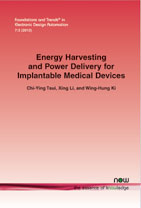Energy Harvesting and Power Delivery for Implantable Medical Devices
By Chi-Ying Tsui, Department of Electronic and Computer Engineering, Hong Kong University of Science and Technology, China, eetsui@ust.hk | Xing Li, Department of Electronic and Computer Engineering, Hong Kong University of Science and Technology, China, xjimmylee@ust.hk | Wing-Hung Ki, Department of Electronic and Computer Engineering, Hong Kong University of Science and Technology, China, eeki@ece.ust.hk
Abstract
Providing a constant and perpetual energy source is a key design challenge for implantable medical devices. Harvesting energy from the human body and the surrounding is one of the possible solutions. Delivering energy from outside the body through different wireless media is another feasible solution. In this monograph, we review different state-of-the-art mechanisms that do "in-body" energy harvesting as well as "out-of-body" wireless power delivery. Details of the energy sources, transmission media, energy harvesting and coupling techniques, and the required energy transducers will be discussed. The merits and disadvantages of each approach will be presented. Different mechanisms have very different characteristics on their output voltage, amount of harvested power and power transfer efficiency. Therefore different types of power conditioning circuits are required. Issues of designing the building blocks for the power conditioning circuits for different energy harvesting or coupling mechanisms will be compared.
Energy Harvesting and Power Delivery for Implantable Medical Devices
Implantable Medical Devices (IMD) have been used since the implantable pacemaker in 1958. Since then, numerous types of IMDs have been introduced to tackle a variety of health issues. Providing a constant and perpetual energy source is a key design challenge for IMDs. Harvesting energy from the human body and its surroundings is one of the possible solutions. Delivering energy from outside the body through different wireless media is another feasible solution.
Energy Harvesting and Power Delivery for Implantable Medical Devices reviews different state-of-the-art mechanisms that do in-body energy harvesting as well as out-of-body wireless power delivery. The details of the energy source, transmission media, energy harvesting and coupling techniques, and the required energy transducers are discussed. The merits and disadvantages of each of these approaches are presented. Different mechanisms have very different characteristics in terms of their output voltage, amount of harvested power, and power transfer efficiency. Therefore different types of power conditioning circuits are required. This monograph compares and contrasts the issues and solutions to designing the building blocks for the power conditioning circuits for different energy harvesting or coupling mechanisms.
